Enroute
An Enroute procedure traverses between the end of the previous procedure and the site of the current procedure, calculating trajectory and performance based on aircraft performance models. That is, it will climb (descend) to the specified altitude using the climb (descent) model, and then cruise using the cruise model. Enroute considers the specific at the end of the last procedure and sets the aircraft to a specified heading at the end of the current procedure.
If the aircraft cannot achieve the defined altitude (either by using the default cruise altitude or by specifying an altitude), you can specify if the aircraft stops at the highest or lowest altitude attainable, depending on whether it was ascending or descending, or if it must level off at altitude. If directed to level off at altitude, the aircraft performs climbing off turns at the end of the maneuver as necessary to achieve the desired altitude.
Enroute should be used for instrument flight rules or other controlled navigation, or when the flight path calls for climb or descent to constant altitude cruise. The methodology of the Enroute procedure is the default methodology used by Aviator when calculating a route between procedures, such as traveling from the end of the previous procedure to the beginning of a holding pattern. Basic point to point should be used to reflect visual flight rules, tactical/combat situations, or building a flight path that can use Arc-Line-Arc geometry.
The procedure contains one control point - the procedure site - as indicated in the diagram below.
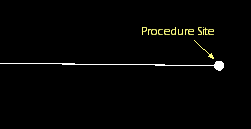
Altitude
| Field
|
Description
|
| Use Aircraft Default Cruise Altitude
|
Select this check box to define the altitude of the procedure using the default cruise altitude specified in the currently selected cruise performance model.
|
| MSL Altitude
|
If Use Aircraft Default Cruise Altitude is not checked, define the aircraft's altitude - using the Mean Sea Level (MSL) reference - for the procedure.
The altitude is constrained by the lowest ceiling value of the active performance models in the current mission phase. |
| Must level off at altitude
|
Select this check box to require the aircraft to level off at the specified altitude. A maneuver is used to bring the aircraft to the altitude specified for a procedure if it is unable to attain that altitude during the course of the procedure. If this option is not selected, the aircraft will simply achieve the highest or lowest - if climbing or descending, respectively - altitude possible while performing the procedure.
|
| Level Off Maneuver
|
A level off maneuver is used to bring an aircraft to the altitude specified for a procedure, if the aircraft is unable to attain that altitude during the course of that procedure. Select from the following leveling off options:
- Automatic - Aviator will determine if a level off maneuver is required, and the direction of the maneuver if needed.
- Left Turn - The direction of the maneuver will be a left turn.
- Right Turn - The direction of the maneuver will be a right turn.
- No Turn - A maneuver will not be performed. If a level off maneuver is required to reach the specified altitude, then the procedure will be invalidated.
|
Navigation Options
Navigation Options parameters define the heading or course of the aircraft at the beginning of the procedure and the direction of turns taken to arrive at the procedure site.
Table - Navigation Options Parameters
| Parameter |
Description
|
| Nav Mode |
The heading or course of the aircraft at the beginning of the procedure. Select from the following options:
- Fly Direct - The aircraft will fly directly to the procedure site from the end of the previous procedure, turning as necessary.
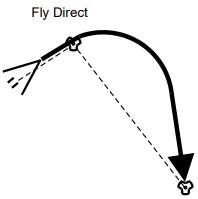
- Arrive on Course for Next Procedure - The aircraft will start or arrive at the procedure site on a course determined by the next procedure so as to avoid an immediate turn correction by the next procedure.
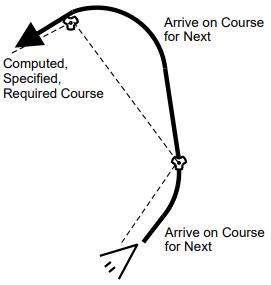
- Arrive on Course - The aircraft will start or arrive at the procedure site on a specific course. The course and then specify a True or Magnetic north reference using the drop-down menu.
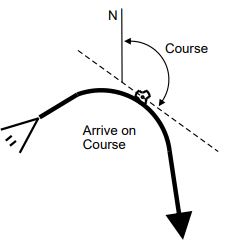
- Inscribed Turn - The aircraft will perform an inscribed turn, placing it on a course to the first control point of the next procedure at a point no further than half of the distance to that waypoint. The aircraft will attempt to adhere to the Turn Factor, but will reduce that value if needed to ensure that it does not arrive on the final course beyond the halfway mark. Similarly, the aircraft may violate the acceleration performance model to ensure that it completes the turn in the proper distance; in the event that the model is violated, information will be displayed in the Message Viewer. When performing an inscribed turn, the aircraft will not pass over the current procedure's site unless the turn radius is zero.
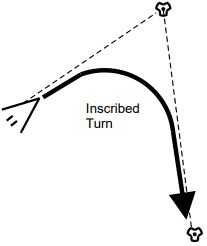
- Arrive on Heading into Wind - The aircraft will start or arrive at the procedure site on a heading into the wind.
|
| First Turn |
The direction of the turn made from the end of the previous procedure as the aircraft sets its course toward the procedure site. If the selected Nav Mode does not include a turn, then this parameter will be ignored. Select from the following options:
- Automatic - STK's Aviator capability will determine the direction of the turn.
- Turn Left - Specifies a left turn.
- Turn Right - Specifies a right turn.
|
| Second Turn |
The direction of the turn made to achieve the outbound course at the procedure site. If the selected Nav Mode does not include a turn, then this parameter will be ignored. Select from the following options:
- Automatic - Aviator will determine the direction of the turn.
- Turn Left - Specifies a left turn.
- Turn Right - Specifies a right turn.
|
Enroute Options
Enroute Options define maneuvering performance characteristics of the aircraft during enroute segments of the procedure.
Table - Enroute Options Parameters
| Option |
Description |
| Delay Enroute Climbs and Descents
|
Select this check box to have the aircraft begin climbing or descending at a point in time during the procedure such that it won't achieve the new altitude until the start of the arc or pattern, or until it has reached the procedure site (whichever is applicable to the specific procedure). |
| Use Max Speed When Computing Turn Radii |
Select this check box to force the aircraft maintain its cruise speed when turning, even if doing so will result in the aircraft making a turn large enough that it takes longer to complete than it would complete a slower, smaller turn. |
| Turn Factor
|
The Turn Factor is the maximum amount - expressed as a multiplier - that the turn radius will be increased to minimize the bank angle required to complete the turn. The factor is applied only to turns that are performed enroute to the procedure's first control point. The full circles that correspond (or are tangent) to the start/stop turns at the extended radius may not intersect if the factor is set high enough. This parameter is a limit and may not actually be achieved due to the requirement to generate an appropriate turn sequence. You can adjust the slider or enter the value manually in the box, with the minimum value being 1 and the maximum value being 10. |
Enroute Cruise Airspeed
Enroute Cruise Airspeed parameters define the airspeed performance characteristics of the aircraft during enroute segments of the procedure.
Table - Enroute Cruise Airpseed Parameters
| Parameter |
Description |
| Airspeed Type |
Select the method for determining the airspeed from the following options:
- Minimum Airspeed - constant airspeed at the minimum cruising airspeed for the aircraft.
- Max Endurance Airspeed - variable airspeed that maximizes the length of time that the aircraft can remain in flight.
- Max Range Airspeed - variable airspeed that maximizes the distance that the aircraft can fly.
- Max Performance Airspeed – a custom performance airspeed and fuel flow that you can use to model specific flight conditions.
- Maximum Airspeed - constant airspeed at the maximum cruising airspeed for the aircraft.
- Other Airspeed - constant, manually defined airspeed.
With the exception of Other Airspeed, the actual airspeed will be defined by the currently selected cruise performance model, or possibly by the currently selected climb or descent performance model if the aircraft is climbing or descending.
|
| Airspeed |
Displays the airspeed. If the airspeed type is Other Airspeed, enter the desired airspeed value; otherwise, the calculated value will be displayed and cannot be edited. Select a reference from the drop-down menu - true airspeed (), calibrated airspeed (), equivalent airspeed (), or number. |

![]()
![]()